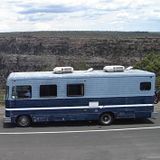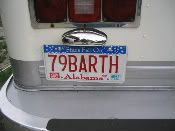Go to...  | Start A New Topic  | Search  | Notify  | Tools  | Reply To This Topic  |  |
 1/12 1/12 |
what is the overall opinion about the location of the sender when installing a trans temp gauge? Was planning to install in trans line @ cooler Installed a B&M cooler but not sure which line to use and have read several different opinions. 454-turbo 425 trans. P-32. Hope to finish this thing one day!!!! Thanks Richard Richard & Robin
| |||||
|
I've done both....here's my two cents: Installing sender in-line provides good entertainment value, as needle constantly moves with grade changes, etc. Since fluid deterioration is a result of both temperature and time, temp spikes may not be as evil as we might think..... A sender in the pan tells me the temp of the bulk of the fluid that's in a ready-to-go-to-work status. That info has value to me, and monitoring the overall trend upward warns me when I'm reaching the caution zone. 'Course, at 24', non-towing, extra deep pan, bigger cooler & flatlands, I've yet to have the gauge tell me much of a anything of concern.... ...Let the debate begin...... | ||||
|
Captain Doom |
Like Lee, I have an extra-capacity/extra-cooling pan (Mag-Hytec) pan in mine. The sender fitting is near the bottom of the pan. On long grades (5 miles @8%), it'll get up to about 205°F with OAT at around 85°F. Normally, it runs at 160-170°F. Mine is cooled only by the coil in the radiator, but I went to an external engine oil cooler, so the rad has less heat to dissipate. The Mag-Hytec pan dropped temps about 15-20°. Rusty '94 28' Breakaway: MilSpec AMG 6.5L TD 230HP Nelson and Chester, not-spoiled Golden Retrievers Sometimes I think we're alone in the universe, and sometimes I think we're not. In either case the idea is quite staggering. - Arthur C. Clarke It was a woman who drove me to drink, and I've been searching thirty years to find her and thank her - W. C. Fields | |||
|
 1/12 1/12 |
Which trans do you have ? I looked on there web page and could not find one for a turbo 400. I believe mine is a 475 but they are supposed to be the same externally. I E-Mailed them to find out if one if available. It looks like a very good pan. I am convinced now to put in the pan I just put the trans.in and did not want to pull the pan off. Guess i will find a pan and install it after the December gathering. buy that time i will need to change oil anyway,besides i still have a ton of work to get ready for that trip . I am really looking forward to it Thanks Richard Richard & Robin
| ||||||
|
Captain Doom |
I have the 4L80E. I also got their diffy cover (holds an extra 2 qts.) Rusty '94 28' Breakaway: MilSpec AMG 6.5L TD 230HP Nelson and Chester, not-spoiled Golden Retrievers Sometimes I think we're alone in the universe, and sometimes I think we're not. In either case the idea is quite staggering. - Arthur C. Clarke It was a woman who drove me to drink, and I've been searching thirty years to find her and thank her - W. C. Fields | |||
|
Here's the pan I used: http://www.transmissionpartsusa.com/TH400_deep_transmis..._p/600-000014102.htm Ya still need to install your own plug for draining and/or temp sending unit. | ||||
|
| First Month Member |
GM says to run the oil from the trans to the radiator heat exchanger then through the aftermarket cooler. GM also says to put the sensor in the converter out line, as this gives you advance warning of an impending overheat condition, and allows you to shift down, back off the throttle, turn off dash air, turn on the electric fan, etc, before things get too hot. The trans pan temperature is good for telling you if you have a big enough cooler. If your cooler is big enough, the trans pan temp will never get too high, and you won't have to watch either the pan temp or the converter out temp. I should add here that most of my trans heat incidents have involved heat, hills, low gears and low, low speeds. Even a couple of coolers ago, we never saw trans heat get very high on highway hills. It is always the slow, steep stuff, or backing back and forth to get into or out of a spot that does it. But, I suspect we go in worse places than many, and are feeding a little more torque into the converter with the 502. I use a single gauge with two switched senders, one for converter out and one for pan temp. As far as pans, most P30s already come with a deep steel pan, so there is no need to pay much attention to the extra capacity the ads mention. However, there is no doubt that a finned aluminum pan offers some cooling advantage, in addition to acting as a girdle to give the trans some extra rigidity in heavy service. Our Barth presently sports a BTE deep pan. I like them because they offer a solid well-made, deep-finned pan for the money. It comes with a nice sand cast finish, which provides a little extra surface area, and I add to that by having it black oxidized, inside and out. It has a drain hole aready, and the sidewalls are thick enough to thread for a 1/8-27 NPT sender. Beware of Chinese cast aluminum trans pans. . 84 30T PeeThirty-Something, 502 powered | |||
|
 |
Nice info Bill H! Which aftermarket cooler do you like? Since I'll want to set up sensors also, I'll need to know the flow direction of the fluid through the transmission lines. Can you tell me which is the output from the TH400? thanks, Matt 1987 Barth 27' P32 Chassis Former State Police Command Post Chevrolet 454 Weiand Manifold, Crane Cam, Gibson Exhaust | |||
|
From Wikipedia: "Transmission fluid cooler line connections are found on the right hand side of the THM400. The lower connection is the cooler feed, and the upper connection is the return. The case is tapped for either self-sealing 1/4"NPT fittings, or 1/2"UNF fittings with a washer seal. 5/16" or 3/8" rigid coolant lines are generally connected via appropriate double-flared adapters." Per square inch of surface area, stacked plate coolers are more efficient than serpentine-finned types....Googling: "Transmission Cooler" will make you an "expert" in no time. | ||||
|
| First Month Member |
Buying a trans cooler is a crapshoot. If you bought too big, you will have spent a little more money than necessary. If you bought too small, you gotta buy another one, and now have a used cooler you don't need and you will have to do all that work and spend all that money a second time. Either way, you don't know until you go up that big hill on a hot day or find yourself stalling the converter with little or no air movement. I would put in the biggest Long Tru-Cool, like the 4739 the first time. It is one of the very few that actually give a BTU rating instead of a blue-sky load rating. My previous cooler, a B&M 70266, proved to be inadequate. It is rated at 28,000 lbs gvw by B&M, but couldn’t handle 20,000 lbs. Both are of stacked plate construction. I use another 70266 as my engine oil cooler, and it works fine. HERE is a Google link to more info on the 4739. However, the single 4739 has proven inadequate, and I have added a B&M 70274 in series with it. Time will tell. If you have it in good air flow, like in front of the radiator, a fan might not be necessary. But if you heat up the converter in traffic, crawling twisty hills, or fighting your way into a difficult boondocking site, a fan is a necessity. In particular, a fan can be useful if you kick it on before a potential high heat situation. Again, you don't really know until you get too hot. However if you install the True Cool without a fan, you can add a fan later if it is needed. Fans are pretty economical and easy to install, even after the fact. So, go big now, and be sure. It might even save you money and time. I would recommend a 3000 CFM puller fan behind the radiator, anyway, to avoid shutdown heat soak. Mine has a thermostat that kicks in right after shutdown to save my starter solenoid, plug wires, vacuum lines, oil lines, and even the exhaust manifolds from heat soak. I have also wired it with a manual on switch so that I can turn it on ahead of time if I anticipate a little heat drama
As Lee said, it is the lower one. However, it is easy to make a mistake tracing them visually, especially if yours cross over to the driver's side. What I do is have my wife or son run the engine in D with the foot on the brake and load the throttle a little. Then, the warmest line is converter out. The rule of thumb is 10 degrees temp rise per minute of compresser stall, so it doesn't take long. I suppose you could do it single-handed by stalling the compressor for a while and then getting out and under for a temp check, but have never actually done it. . 84 30T PeeThirty-Something, 502 powered | |||
|
| Powered by Social Strata |
| Please Wait. Your request is being processed... |
|
This website is dedicated to the Barth Custom Coach, their owners and those who admire this American made, quality crafted, motor coach.
We are committed to the history, preservation and restoration of the Barth Custom Coach.
We are committed to the history, preservation and restoration of the Barth Custom Coach.



